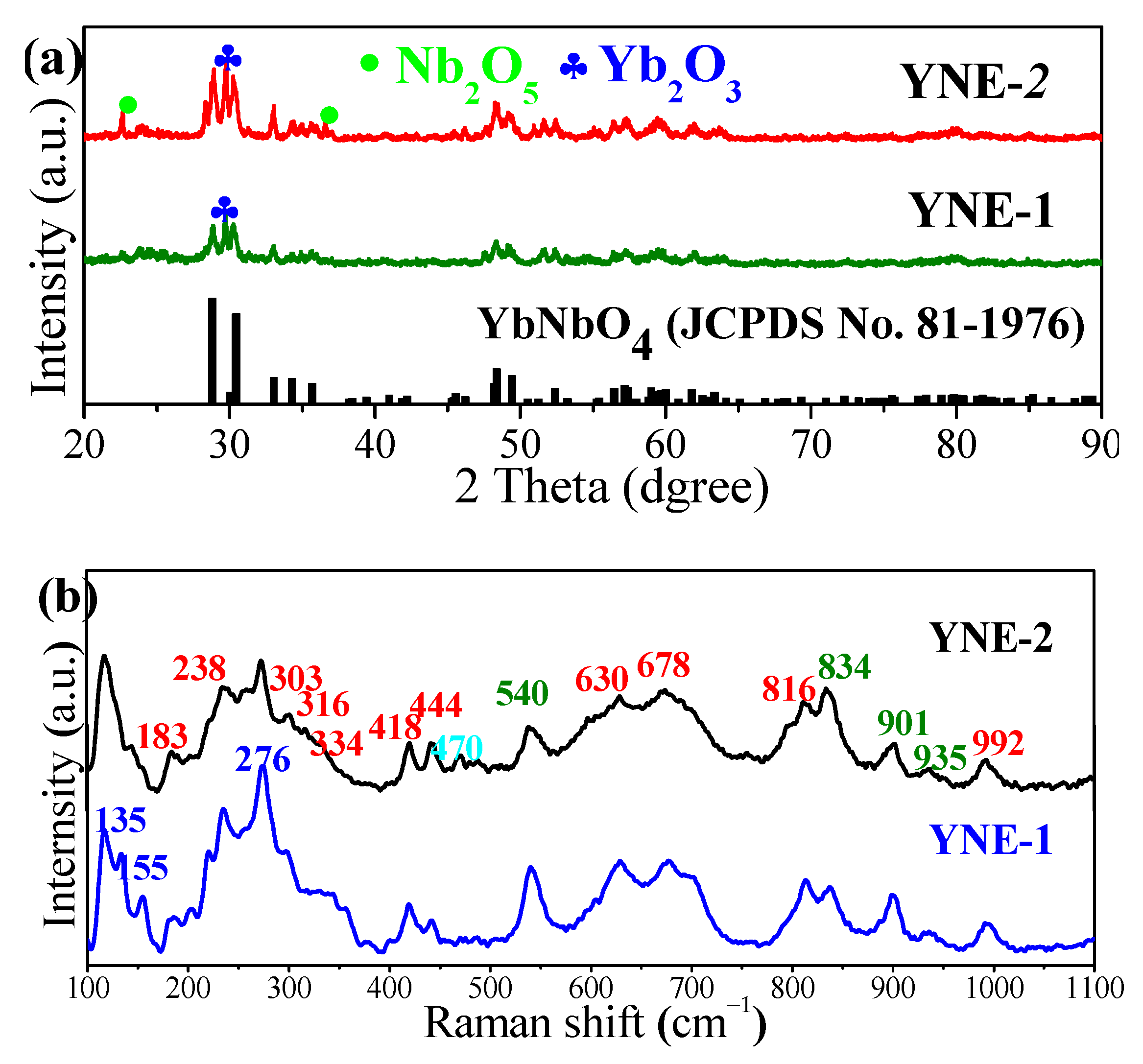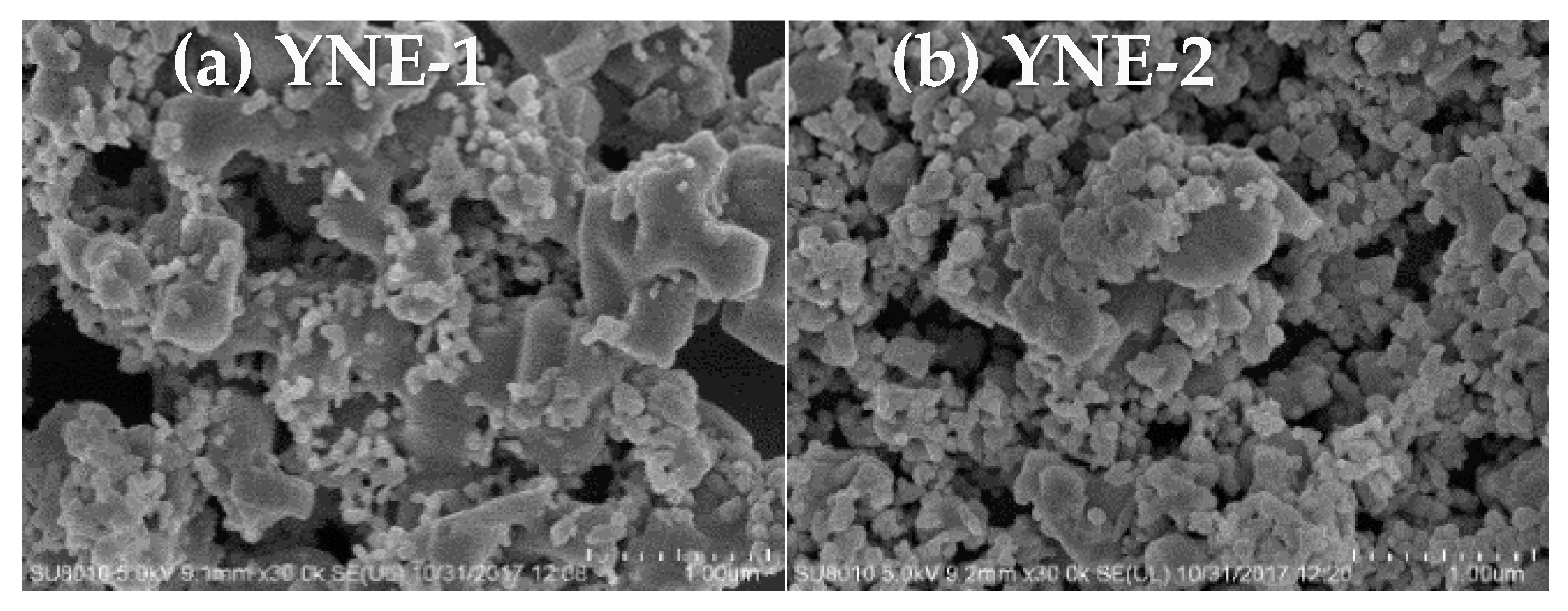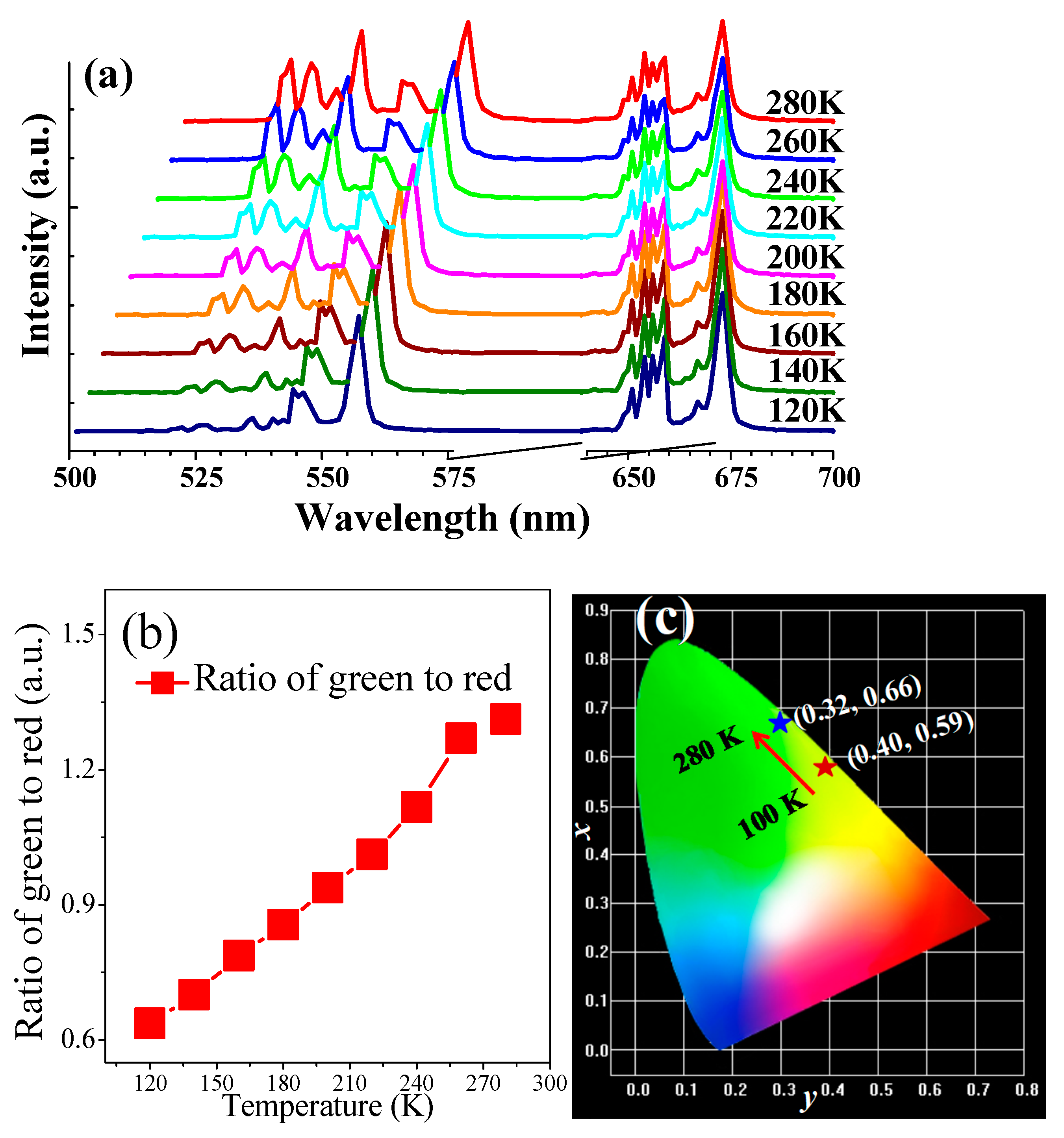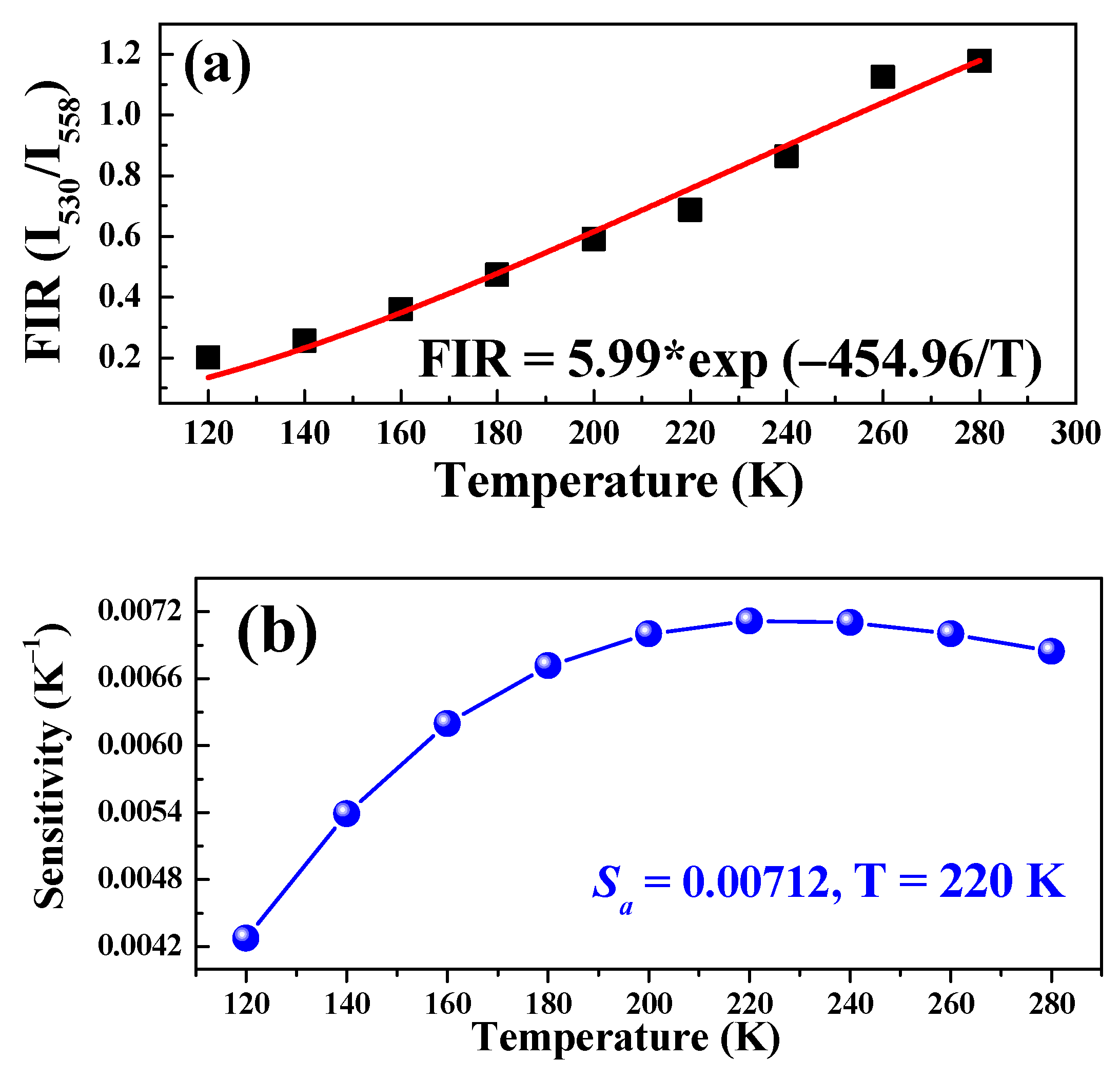Optical Temperature Sensing of YbNbO4:Er3+ Phosphors Synthesized by Hydrothermal Method
Abstract
1. Introduction
2. Materials and Methods
3. Results
4. Conclusions
Author Contributions
Funding
Institutional Review Board Statement
Informed Consent Statement
Data Availability Statement
Conflicts of Interest
References
- Shang, Y.; Han, Q.; Hao, S.; Chen, T.; Zhu, Y.; Wang, Z.; Yang, C. Dual-Mode upconversion nanoprobe enables broad-range thermometry from cryogenic to room temperature. ACS Appl. Mater. Inter. 2019, 11, 42455. [Google Scholar] [CrossRef] [PubMed]
- Pan, E.; Bai, G.; Wang, L.; Lei, L.; Chen, L.; Xu, S. Lanthanide ion-doped bismuth titanate nanocomposites for ratiometric thermometry with low pump power density. ACS Appl. Nano Mater. 2019, 2, 7144. [Google Scholar] [CrossRef]
- Zhang, J.; Chen, Y. Y4.67Si3O13-based phosphors: Structure, morphology and upconversion luminescence for optical thermometry. J. Am. Ceram. Soc. 2019, 102, 5471. [Google Scholar] [CrossRef]
- Liu, L.; Tang, D.; Xu, L.; Khan, F.; Din, I.U.; Wang, Z.; Li, P.; Li, H.; Zhao, E.; Zhang, Y. Novel optical thermometer through upconversion emission of Ho3+ sensitized by Nd3+. J. Lumin. 2019, 213, 40. [Google Scholar] [CrossRef]
- Bastos, R.N.; Brites, C.D.S.; Rojas-Gutierrez, P.A.; DeWolf, C.; Ferreira, R.A.S.; Capobianco, J.A.; Carlos, L.D. Thermal properties of lipid bilayers determined using upconversion nanother-mometry. Adv. Funct. Mater. 2019, 29, 1905474. [Google Scholar] [CrossRef]
- Choudhary, K.; Dwivedi, A.; Bahadur, A.; Yadav, T.P.; Rai, S.B. Enhanced upconversion emission and temperature sensor sensitivity in presence of Bi3+ ions in Er3+/Yb3+ co-doped MgAl2O4 phosphor. Ceram. Int. 2018, 44, 9633. [Google Scholar] [CrossRef]
- Liu, S.; Cui, J.; Jia, J.; Fu, J.; You, W.; Zeng, Q.; Yang, Y.; Ye, X. High sensitive Ln3+/Tm3+/Yb3+ (Ln3+ = Ho3+, Er3+) tri-doped Ba3Y4O9 upconverting optical thermometric materials based on diverse thermal response from non-thermally coupled energy levels. Ceram. Int. 2019, 45, 1. [Google Scholar] [CrossRef]
- Tong, L.; Li, X.; Zhang, J.; Xu, S.; Sun, J.; Cheng, L.; Zheng, H.; Zhang, Y.; Zhang, X.; Hua, R.; et al. Microwave-assisted hydrothermal synthesis, temperature quenching and laser-induced heating effect of hexagonal microplate β-NaYF4: Er3+/Yb3+ microcrystals under 1550 nm laser irradiation. Sensor. Actuat. B Chem. 2017, 246, 175. [Google Scholar] [CrossRef]
- Liu, X.; Lei, R.S.; Huang, F.F.; Deng, D.G.; Wang, H.P.; Zhao, S.L.; Xu, S.Q. Upconversion luminescence, intrinsic optical bistability, and optical thermometry in Ho3+/Yb3+:BaMoO4 phosphors. Chin. Opt. Lett. 2019, 17, 11. [Google Scholar] [CrossRef]
- Kaczmarek, M.; Kaczmarek, M.K.; van Deun, R. Er3+-to-Yb3+ and Pr3+-to-Yb3+ energy transfer for highly efficient near-infrared cryogenic optical temperature sensing. Nanoscale 2019, 11, 833. [Google Scholar] [CrossRef]
- Hou, J.; Zhou, R.; Zhang, J.; Wang, Z.; Zhang, Z.; Ding, Z. Pressure and temperature study on the structural stability of GdNbO4:Eu3+. J. Phys. Chem. C 2017, 121, 14787. [Google Scholar] [CrossRef]
- Brunckova, H.; Mudra, E.; Medvecky, L.; Kovalcikova, A.; Durisin, J.; Sebek, M.; Girman, V. Effect of lanthanides on phase transformation and structural properties of LnNbO4 and LnTaO4 thin films. Mater. Des. 2017, 134, 455. [Google Scholar] [CrossRef]
- Brunckova, H.; Kolev, H.; Rocha, L.A.; Nassar, E.J.; Moscardini, S.B.; Medvecky, L. XPS characterization and luminescent properties of GdNbO4 and GdTaO4 thin films. Appl. Surf. Sci. 2020, 504, 144358. [Google Scholar] [CrossRef]
- Huang, H.; Zhou, H.; Zhou, J.; Wang, T.; Huang, D.; Wu, Y.; Sun, L.; Zhou, G.; Hu, J.Z.J. Enhanced anti-stocks luminescence in LaNbO4:Ln3+ (Ln3+ = Yb3+, Er3+/Ho3+/Tm3+) with abundant color. RSC Adv. 2017, 7, 16777. [Google Scholar] [CrossRef]
- Carmo, F.F.d.; Nascimento, J.P.C.d.; Façanha, M.X.; Sales, T.O.; Santos, W.Q.; Gouveia-Neto, A.S.; Jacinto, C.; Sombra, A.S.B. White light upconversion emission and color tunability in Er3+/Tm3+/Yb3+ tri-doped YNbO4 phosphor. J. Lumin. 2018, 204, 676. [Google Scholar] [CrossRef]
- Mao, J.; Jiang, B.; Wang, P.; Qiu, L.; Abass, M.T.; Wei, X.; Chen, Y.; Yin, M. Study on temperature sensing performance based on the luminescence of Eu3+ and Er3+ co-doped YNbO4. Dalton Trans. 2020, 49, 8194. [Google Scholar] [CrossRef]
- Jakeš, V.; Rubešová, K.; Hlásek, T.; Polák, V.; Oswald, J.; Nádherný, L. Thin films of ErNbO4 and YbNbO4 prepared by sol-gel. J. Sol Gel. Sci. Technol. 2016, 78, 600. [Google Scholar] [CrossRef]
- Caixeta, F.; Bastos, A.R.N.; Botas, A.M.P.; Rosa, L.S.; Souza, V.S.; Borges, F.H.; Neto, A.N.C.; Ferrier, A.; Goldner, P.; Carlos, L.D.; et al. High-Quantum-yield upconverting Er3+/Yb3+-Organic−inorganic hybrid dual coatings for real-time temperature sensing and photothermal conversion. J. Phys. Chem. C 2020, 124, 19892–19903. [Google Scholar] [CrossRef]
- Siqueira, K.P.F.; Moreira, R.L.; Dias, A. Synthesis and crystal structure of lanthanide orthoniobates studied by vibrational spectroscopy. Chem. Mater. 2010, 22, 668. [Google Scholar] [CrossRef]
- Yang, M.; Zhao, X.; Ji, Y.; Liu, F.; Liu, W.; Sun, J.; Liu, X. Hydrothermal approach and luminescent properties for the synthesis of orthoniobates GdNbO4:Ln3+ (Ln = Dy, Eu) single crystals under high-temperature high-pressure conditions. New J. Chem. 2014, 38, 4249. [Google Scholar] [CrossRef]
- Jehng, J.M.; Wachs, I.E. Structural chemistry and raman spectra of niobium oxides. Chem. Mater. 1991, 3, 100. [Google Scholar] [CrossRef]
- Balachandran, U.; Eror, N.G. Raman spectrum of the high temperature form of Nb2O5. J. Mater. Sci. 1982, 1, 374. [Google Scholar] [CrossRef]
- Huang, X.; Wang, K.; Church, J.S.; Li, Y. Characterization of oxides on niobium by raman and infrared spectroscopy. Electrochim. Acta 1999, 44, 2571. [Google Scholar] [CrossRef]
- Gu, J.J.; Steiner, D.; Mogonye, J.E.; Aouadi, S.M. Precipitation-induced healing of Nb2O5. J. Eur. Ceram. Soc. 2017, 37, 4141–4146. [Google Scholar] [CrossRef]
- Yan, A.; Wu, P.; Zhang, S.; Liang, L.; Yang, F.; Pei, Y.L.; Chen, S. Assignments of the Raman modes of monoclinic erbium oxide. J. Appl. Phys. 2013, 114, 193502. [Google Scholar] [CrossRef]
- Nascimento, J.P.C.; Sales, A.J.M.; Sousa, D.G.; da Silva, M.A.S.; Moreira, S.G.C.; Pavani, K.; Soares, M.J.; Graça, M.P.F.; Kumar, J.S.; Sombra, A.S.B. Temperature-, power-, and concentration dependent two and three photon upconversion in Er3+/Yb3+ co-doped lanthanum ortho-niobate phosphors. RSC Adv. 2016, 6, 68160. [Google Scholar] [CrossRef]
- Kocsor, L.; Péter, L.; Corradi, G.; Kis, Z.; Gubicza, J.; Kovács, L. Mechanochemical reactions of lithium niobate induced by high-energy ball-milling. Crystals 2019, 9, 334. [Google Scholar] [CrossRef]
- Li, G.; Li, C.; Xu, Z.; Cheng, Z.; Lin, J. Facile synthesis, growth mechanism and luminescence properties of uniform La(OH)3:Ho3+/Yb3+ and La2O3:Ho3+/Yb3+ nanorods. CrystEngComm 2010, 12, 4208. [Google Scholar] [CrossRef]
- Xu, B.X.; Song, C.; Song, J.; Huang, R.C.; Liu, J.; Lin, Z.X.; Zhang, Y.; Song, J.; Li, H.L. Effect of Rb+ Doping on Tunable Luminescence in Yb3+/Er3+-Y2O3 Film. Coatings 2020, 10, 1137. [Google Scholar] [CrossRef]
- Dong, J.; Li, Y.; Zheng, W.; Wang, R.; Xu, Y. Lower power dependent upconversion multicolor tunable properties in TiO2:Yb3+/Er3+/ (Tm3+). Ceram. Int. 2019, 45, 432. [Google Scholar] [CrossRef]
- dos Santos, P.V.; Gouveia, E.A.; de Araujo, M.T.; Gouveia-Neto, A.S.; Sombra, A.S.B.; Neto, J.A.M. Thermally induced threefold upconversion emission enhancement in nonresonant excited Er3+/Yb3+-codoped chalcogenide glass. Appl. Phys. Lett. 1999, 74, 3607. [Google Scholar] [CrossRef]
- Lü, Y.; Tang, X.; Yan, L.; Li, K.; Liu, X.; Shang, M.; Li, C.; Lin, J. Synthesis and luminescent properties of GdNbO4:RE3+ (RE = Tm, Dy) nanocrystalline phosphors via the Sol-Gel process. J. Phys. Chem. C 2013, 117, 21972. [Google Scholar] [CrossRef]
- Guo, J.; Ren, J.; Cheng, R.; Dong, Q.; Gao, C.; Zhang, X.; Guo, S. Growth, structural and thermophysical properties of TbNbO4 crystals. CrystEngComm. 2018, 20, 1455. [Google Scholar] [CrossRef]
- Zhao, X.; Suo, H.; Zhang, Z.; Guo, C. Spectral pure RGB up-conversion emissions in self-assembled Gd2O3:Yb3+, Er3+/Ho3+/Tm3+ 3D hierarchical architectures. Ceram. Int. 2018, 44, 2911. [Google Scholar] [CrossRef]
- Peng, H.; Ding, B.; Ma, Y.; Sun, S.; Tao, W.; Guo, Y.; Guo, H.; Yang, X.; Qian, H. Sequential growth of sandwiched NaYF4:Yb/Er@NaYF4:Yb @NaNdF4:Yb core-shell-shell nanoparticles for photodynamic therapy. Appl. Surf. Sci. 2015, 357, 2408. [Google Scholar] [CrossRef]
- Chen, G.; Somesfalean, G.; Liu, Y.; Zhang, Z.; Sun, Q.; Wang, F. Upconversion mechanism for two-color emission in rare-earth-ion-doped ZrO2 nanocrystals. Phys. Rev. B 2007, 75, 195204. [Google Scholar] [CrossRef]
- Gong, H.; Yang, D.; Zhao, X.; Pun, E.Y.B.; Lin, H. Upconversion color tunability and white light generation in Tm3+/Ho3+/Yb3+ doped aluminum germanate glasses. Opt. Mater. 2010, 32, 554. [Google Scholar] [CrossRef]
- Liu, G.; Sun, Z.; Fu, Z.; Ma, L.; Wang, X. Temperature sensing and bio-imaging applications based on polyethylenimine/ CaF2 nanoparticles with upconversion fluorescence. Talanta 2017, 169, 181. [Google Scholar] [CrossRef]
- Ding, M.; Lu, C.; Chen, L.; Bai, W.; Yuan, Y.; Ji, Z. Transparent sol-gel glass ceramics containing β-NaYF4:Yb3+/Er3+ nanocrystals: Structure, upconversion luminescent properties and optical thermometry behavior. Ceram. Int. 2018, 44, 16379. [Google Scholar] [CrossRef]
- Tian, X.; Dou, H.; Wu, L. Non-contact thermometry with dual-activator luminescence of Bi3+/Sm3+: YNbO4 phosphor. Ceram. Int. 2020, 46, 10641. [Google Scholar] [CrossRef]
- Du, P.; Huang, X.; Yu, J.S. Yb3+-Concentration dependent upconversion luminescence and temperature sensing behavior in Yb3+/Er3+ codoped Gd2MoO6 nanocrystals prepared by a facile citric-assisted sol-gel method. Inorg. Chem. Front. 2017, 4, 1987. [Google Scholar] [CrossRef]
- Du, P.; Luo, L.; Yu, J.S. Low-temperature thermometry based on upconversion emission of Ho/Yb-codoped Ba0.77Ca0.23TiO3 ceramics. J. Alloys Compd. 2015, 632, 73. [Google Scholar] [CrossRef]
- Du, P.; Deng, A.M.; Luo, L.; Yu, J.S. Simultaneous phase and size manipulation in NaYF4:Er3+/Yb3+ upconverting nanoparticles for a non-invasion optical thermometer. New J. Chem. 2017, 41, 13855. [Google Scholar] [CrossRef]
- Zou, Z.; Wu, T.; Lu, H.; Tu, Y.; Zhao, S.; Xie, S.; Han, F.; Xu, S. Structure, luminescence and temperature sensing in rare earth doped glass ceramics containing NaY(WO4)2 nanocrystals. RSC Adv. 2018, 8, 7679. [Google Scholar] [CrossRef]
- Singh, K.; Singh, S.K.; Gupta, B.K.; Prakash, R.; Rai, S.B. Probing a highly efficient dual mode: Down-upconversion luminescence and temperature sensing performance of rare-earth oxide phosphors. Dalton Trans. 2013, 42, 1065. [Google Scholar] [CrossRef]





Publisher’s Note: MDPI stays neutral with regard to jurisdictional claims in published maps and institutional affiliations. |
© 2021 by the authors. Licensee MDPI, Basel, Switzerland. This article is an open access article distributed under the terms and conditions of the Creative Commons Attribution (CC BY) license (http://creativecommons.org/licenses/by/4.0/).
Share and Cite
Ji, H.; Tang, X.; Zhang, H.; Li, X.; Qian, Y. Optical Temperature Sensing of YbNbO4:Er3+ Phosphors Synthesized by Hydrothermal Method. Coatings 2021, 11, 383. https://doi.org/10.3390/coatings11040383
Ji H, Tang X, Zhang H, Li X, Qian Y. Optical Temperature Sensing of YbNbO4:Er3+ Phosphors Synthesized by Hydrothermal Method. Coatings. 2021; 11(4):383. https://doi.org/10.3390/coatings11040383
Chicago/Turabian StyleJi, Heming, Xunze Tang, Haiyan Zhang, Xiaolong Li, and Yannan Qian. 2021. "Optical Temperature Sensing of YbNbO4:Er3+ Phosphors Synthesized by Hydrothermal Method" Coatings 11, no. 4: 383. https://doi.org/10.3390/coatings11040383
APA StyleJi, H., Tang, X., Zhang, H., Li, X., & Qian, Y. (2021). Optical Temperature Sensing of YbNbO4:Er3+ Phosphors Synthesized by Hydrothermal Method. Coatings, 11(4), 383. https://doi.org/10.3390/coatings11040383




